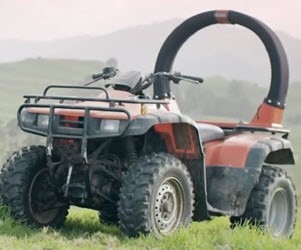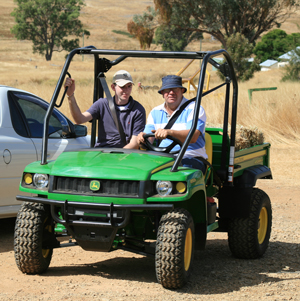Quad bikes are hazardous for people who operate them and work near them.
You must, so far as is reasonably practicable, eliminate or minimise risks associated with using quad bikes. This involves:
-
identifying hazards—find out what could go wrong and what could cause harm.
-
assessing risks if necessary—understand the harm each hazard could cause, how serious the harm could be and the likelihood of it happening.
-
controlling risks—implement the most effective control measures that are reasonably practicable in the circumstances.
-
reviewing control measures to ensure they are working as planned.
If you must use quad bikes, ride them safely and use protective equipment.
Ride quad bikes on flat, stable terrain
Flat terrain is best for quad bikes. You increase risk by riding them on rocky, steep, uneven, sandy or muddy terrain.
Avoid towing attachments or carrying loads if possible
You could make your quad bike unstable and lose control from:
-
towing attachments
-
carrying loads on front or rear racks
-
carrying liquid loads which shift as you turn corners or go up and down slopes.
Avoiding these reduces the risk of rollover accidents.
Use active riding techniques
Active riding techniques help you stay stable in rough terrain:
-
shifting your body weight appropriately when cornering and going up and down hills
-
keeping both hands on the handlebars, and
-
keeping both feet on the footrests.
Some riders, including older people and children, may not be able to use an active riding technique, or maintain it for extended periods of time.
Be mindful that active riding can cause fatigue.
Wear a helmet
Always wear a helmet that fits well when riding a quad bike.
If you ride on a public road, you must wear a helmet that complies with:
-
AS/NZS 1698:2006: Protective helmets for vehicle users
-
United Nations Economic Commission for Europe (UNECE) Regulation 22.05
These helmets meet the requirements for on-road and off-road use.
Operator protection devices
From 11 October 2021, the Consumer Goods (Quad Bikes) Safety Standard 2019 requires operator protection devices (OPDs) to be fitted to:
-
new general use quad bikes
-
imported, second-hand, general-use quad bikes.
OPDs reduce the risk of serious crush injuries and deaths if a quad bike rolls over.
If you buy a quad bike fitted with an OPD, you should not remove it.
If you remove it, you must replace it with something that would provide equivalent or greater protection, such as another type of OPD.
Roll-over protective structures
Unlike OPDs, roll-over protective structures (ROPS) enclose the operator. They are used together with driver/passenger restraints, usually seat belts.
ROPS are not suitable for single operator quad bikes. They are commonly used on side-by-side vehicles, which some people call ‘two-seater quad bikes’.
A quad bike fitted with an OPD. Image courtesy of the ACCC.
A side-by-side vehicle with a ROPS. Image courtesy of the Australian Centre for Agricultural Health and Safety.



